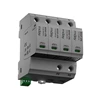How To Select Surge Protector For Different Grounding Methods?
GB50054 "Low Voltage Power Distribution Design Specification": There are three types of grounding for low voltage power distribution systems, namely IT system, TT system, and TN system.
The first letter indicates the relationship between the power supply end and the ground
T: The neutral point of the power transformer is directly grounded. I: The neutral point of the power transformer is not grounded, or is grounded through high impedance.
The second letter indicates the relationship between the exposed conductive part of the electrical device and the ground
T: The exposed conductive part of the electrical device is directly grounded, and this grounding point is electrically independent of the grounding point at the power supply end. N: The exposed conductive part of the electrical device has a direct electrical connection with the grounding point at the power supply end.
The subsequent letters describe the relationship between the neutral line and the protective line: S: The neutral line and the protective line are separated C: The neutral line and the protective line are combined (one conductor)
How to select a surge protector?
Among them, wiring form 1 means that the SPD is installed on the load side of the RCD, and wiring form 2 means that the SPD is installed on the power supply side of the RCD.
Different grounding methods, how to select surge protectors
When the TT system SPD is installed on the load side of the RCD, the 4P wiring mode is used to achieve common mode protection between the L line and the PE line, and between the N line and the PE line.
When the TT system SPD is installed on the power supply side of the RCD, the phase line and the PE line cannot be directly connected, and the wiring mode is 3P+N mode. One of the four surge protectors acts as common mode protection between the N and PE lines, while the other three are connected between the L and N lines to achieve differential mode protection.
Different grounding methods, how to select surge protectors-TN-C system
The TN-C system N line and PE line are combined into one line, called the PEN line. At this time, the circuit system actually connects the phase line and the PEN line separately, which is a 3P wiring mode.
When the TN-S system SPD is installed on the load side of the RCD, the 4P wiring mode is used. When the SPD is installed on the power supply side of the RCD, the phase line and the PE line cannot be directly connected, and the wiring mode is 3P+N mode.
The front part of the TN-C-S system is powered by TN-C, and the back part separates the N line and PE line from the PEN line. The SPD uses 3P at the connection between the N and PE lines, and 4P is used when the SPD is installed after the N and PE lines are separated by 10m, that is, one is added between the N and PE lines.
For IT systems that do not lead out the neutral line, only the 3P wiring mode is actually used; when the SPD of the IT system that leads out the neutral line is installed on the load side of the RCD, the 4P wiring mode is used; when the SPD is installed on the power supply side of the RCD, the phase line and the PE line cannot be directly connected, and the wiring mode is 3P+N.











